Jinxin Hu
Synergistic Integration and Discrepancy Resolution of Contextualized Knowledge for Personalized Recommendation
Oct 16, 2025Abstract:The integration of large language models (LLMs) into recommendation systems has revealed promising potential through their capacity to extract world knowledge for enhanced reasoning capabilities. However, current methodologies that adopt static schema-based prompting mechanisms encounter significant limitations: (1) they employ universal template structures that neglect the multi-faceted nature of user preference diversity; (2) they implement superficial alignment between semantic knowledge representations and behavioral feature spaces without achieving comprehensive latent space integration. To address these challenges, we introduce CoCo, an end-to-end framework that dynamically constructs user-specific contextual knowledge embeddings through a dual-mechanism approach. Our method realizes profound integration of semantic and behavioral latent dimensions via adaptive knowledge fusion and contradiction resolution modules. Experimental evaluations across diverse benchmark datasets and an enterprise-level e-commerce platform demonstrate CoCo's superiority, achieving a maximum 8.58% improvement over seven cutting-edge methods in recommendation accuracy. The framework's deployment on a production advertising system resulted in a 1.91% sales growth, validating its practical effectiveness. With its modular design and model-agnostic architecture, CoCo provides a versatile solution for next-generation recommendation systems requiring both knowledge-enhanced reasoning and personalized adaptation.
Distribution-Guided Auto-Encoder for User Multimodal Interest Cross Fusion
Aug 20, 2025Abstract:Traditional recommendation methods rely on correlating the embedding vectors of item IDs to capture implicit collaborative filtering signals to model the user's interest in the target item. Consequently, traditional ID-based methods often encounter data sparsity problems stemming from the sparse nature of ID features. To alleviate the problem of item ID sparsity, recommendation models incorporate multimodal item information to enhance recommendation accuracy. However, existing multimodal recommendation methods typically employ early fusion approaches, which focus primarily on combining text and image features, while neglecting the contextual influence of user behavior sequences. This oversight prevents dynamic adaptation of multimodal interest representations based on behavioral patterns, consequently restricting the model's capacity to effectively capture user multimodal interests. Therefore, this paper proposes the Distribution-Guided Multimodal-Interest Auto-Encoder (DMAE), which achieves the cross fusion of user multimodal interest at the behavioral level.Ultimately, extensive experiments demonstrate the superiority of DMAE.
DGenCTR: Towards a Universal Generative Paradigm for Click-Through Rate Prediction via Discrete Diffusion
Aug 20, 2025


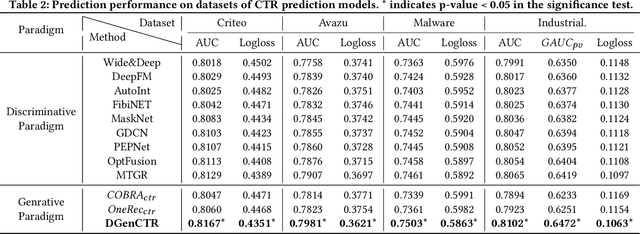
Abstract:Recent advances in generative models have inspired the field of recommender systems to explore generative approaches, but most existing research focuses on sequence generation, a paradigm ill-suited for click-through rate (CTR) prediction. CTR models critically depend on a large number of cross-features between the target item and the user to estimate the probability of clicking on the item, and discarding these cross-features will significantly impair model performance. Therefore, to harness the ability of generative models to understand data distributions and thereby alleviate the constraints of traditional discriminative models in label-scarce space, diverging from the item-generation paradigm of sequence generation methods, we propose a novel sample-level generation paradigm specifically designed for the CTR task: a two-stage Discrete Diffusion-Based Generative CTR training framework (DGenCTR). This two-stage framework comprises a diffusion-based generative pre-training stage and a CTR-targeted supervised fine-tuning stage for CTR. Finally, extensive offline experiments and online A/B testing conclusively validate the effectiveness of our framework.
Global-Distribution Aware Scenario-Specific Variational Representation Learning Framework
Aug 20, 2025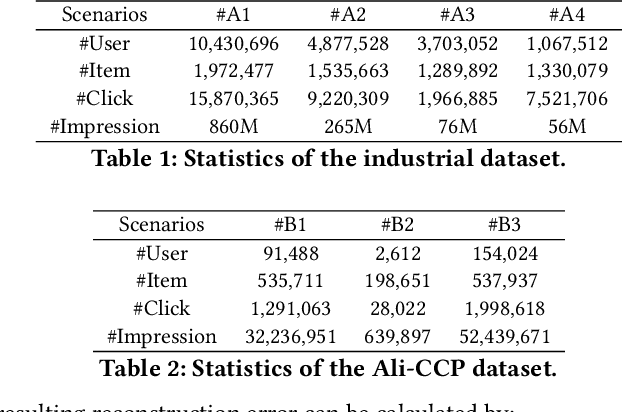
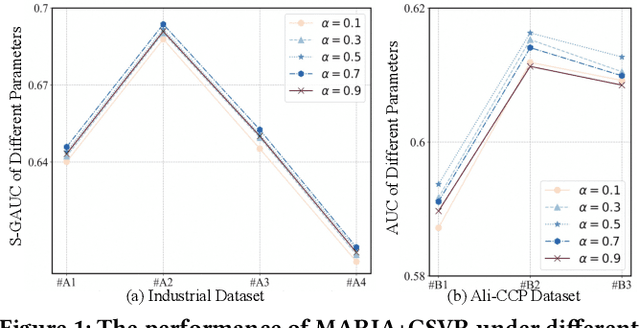
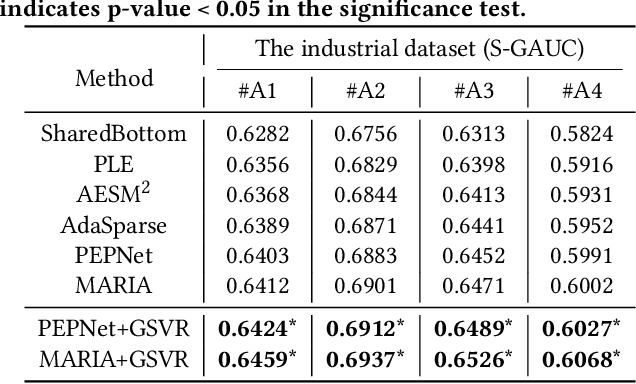
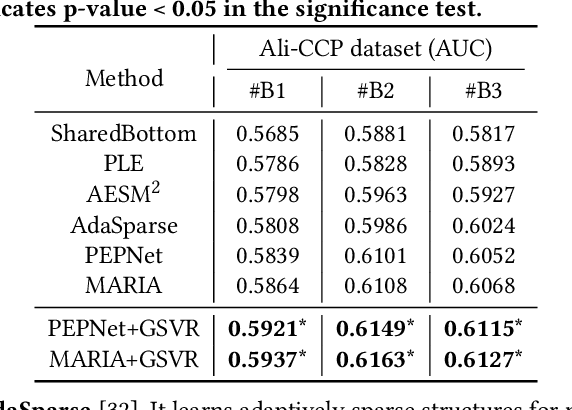
Abstract:With the emergence of e-commerce, the recommendations provided by commercial platforms must adapt to diverse scenarios to accommodate users' varying shopping preferences. Current methods typically use a unified framework to offer personalized recommendations for different scenarios. However, they often employ shared bottom representations, which partially hinders the model's capacity to capture scenario uniqueness. Ideally, users and items should exhibit specific characteristics in different scenarios, prompting the need to learn scenario-specific representations to differentiate scenarios. Yet, variations in user and item interactions across scenarios lead to data sparsity issues, impeding the acquisition of scenario-specific representations. To learn robust scenario-specific representations, we introduce a Global-Distribution Aware Scenario-Specific Variational Representation Learning Framework (GSVR) that can be directly applied to existing multi-scenario methods. Specifically, considering the uncertainty stemming from limited samples, our approach employs a probabilistic model to generate scenario-specific distributions for each user and item in each scenario, estimated through variational inference (VI). Additionally, we introduce the global knowledge-aware multinomial distributions as prior knowledge to regulate the learning of the posterior user and item distributions, ensuring similarities among distributions for users with akin interests and items with similar side information. This mitigates the risk of users or items with fewer records being overwhelmed in sparse scenarios. Extensive experimental results affirm the efficacy of GSVR in assisting existing multi-scenario recommendation methods in learning more robust representations.
CSMF: Cascaded Selective Mask Fine-Tuning for Multi-Objective Embedding-Based Retrieval
Apr 17, 2025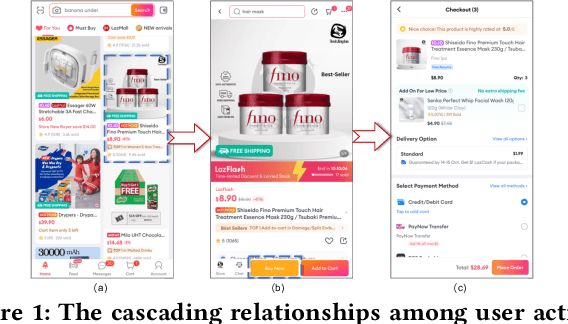

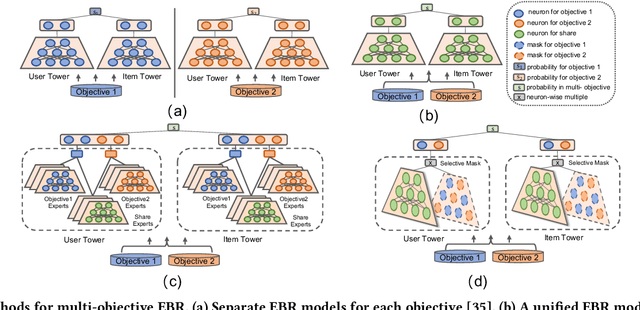

Abstract:Multi-objective embedding-based retrieval (EBR) has become increasingly critical due to the growing complexity of user behaviors and commercial objectives. While traditional approaches often suffer from data sparsity and limited information sharing between objectives, recent methods utilizing a shared network alongside dedicated sub-networks for each objective partially address these limitations. However, such methods significantly increase the model parameters, leading to an increased retrieval latency and a limited ability to model causal relationships between objectives. To address these challenges, we propose the Cascaded Selective Mask Fine-Tuning (CSMF), a novel method that enhances both retrieval efficiency and serving performance for multi-objective EBR. The CSMF framework selectively masks model parameters to free up independent learning space for each objective, leveraging the cascading relationships between objectives during the sequential fine-tuning. Without increasing network parameters or online retrieval overhead, CSMF computes a linearly weighted fusion score for multiple objective probabilities while supporting flexible adjustment of each objective's weight across various recommendation scenarios. Experimental results on real-world datasets demonstrate the superior performance of CSMF, and online experiments validate its significant practical value.
Addressing Information Loss and Interaction Collapse: A Dual Enhanced Attention Framework for Feature Interaction
Mar 14, 2025Abstract:The Transformer has proven to be a significant approach in feature interaction for CTR prediction, achieving considerable success in previous works. However, it also presents potential challenges in handling feature interactions. Firstly, Transformers may encounter information loss when capturing feature interactions. By relying on inner products to represent pairwise relationships, they compress raw interaction information, which can result in a degradation of fidelity. Secondly, due to the long-tail features distribution, feature fields with low information-abundance embeddings constrain the information abundance of other fields, leading to collapsed embedding matrices. To tackle these issues, we propose a Dual Attention Framework for Enhanced Feature Interaction, known as Dual Enhanced Attention. This framework integrates two attention mechanisms: the Combo-ID attention mechanism and the collapse-avoiding attention mechanism. The Combo-ID attention mechanism directly retains feature interaction pairs to mitigate information loss, while the collapse-avoiding attention mechanism adaptively filters out low information-abundance interaction pairs to prevent interaction collapse. Extensive experiments conducted on industrial datasets have shown the effectiveness of Dual Enhanced Attention.
Hierarchical Causal Transformer with Heterogeneous Information for Expandable Sequential Recommendation
Mar 04, 2025Abstract:Sequential recommendation systems leveraging transformer architectures have demonstrated exceptional capabilities in capturing user behavior patterns. At the core of these systems lies the critical challenge of constructing effective item representations. Traditional approaches employ feature fusion through simple concatenation or basic neural architectures to create uniform representation sequences. However, these conventional methods fail to address the intrinsic diversity of item attributes, thereby constraining the transformer's capacity to discern fine-grained patterns and hindering model extensibility. Although recent research has begun incorporating user-related heterogeneous features into item sequences, the equally crucial item-side heterogeneous feature continue to be neglected. To bridge this methodological gap, we present HeterRec - an innovative framework featuring two novel components: the Heterogeneous Token Flattening Layer (HTFL) and Hierarchical Causal Transformer (HCT). HTFL pioneers a sophisticated tokenization mechanism that decomposes items into multi-dimensional token sets and structures them into heterogeneous sequences, enabling scalable performance enhancement through model expansion. The HCT architecture further enhances pattern discovery through token-level and item-level attention mechanisms. furthermore, we develop a Listwise Multi-step Prediction (LMP) objective function to optimize learning process. Rigorous validation, including real-world industrial platforms, confirms HeterRec's state-of-the-art performance in both effective and efficiency.
Efficient Long Sequential Low-rank Adaptive Attention for Click-through rate Prediction
Mar 04, 2025Abstract:In the context of burgeoning user historical behavior data, Accurate click-through rate(CTR) prediction requires effective modeling of lengthy user behavior sequences. As the volume of such data keeps swelling, the focus of research has shifted towards developing effective long-term behavior modeling methods to capture latent user interests. Nevertheless, the complexity introduced by large scale data brings about computational hurdles. There is a pressing need to strike a balance between achieving high model performance and meeting the strict response time requirements of online services. While existing retrieval-based methods (e.g., similarity filtering or attention approximation) achieve practical runtime efficiency, they inherently compromise information fidelity through aggressive sequence truncation or attention sparsification. This paper presents a novel attention mechanism. It overcomes the shortcomings of existing methods while ensuring computational efficiency. This mechanism learn compressed representation of sequence with length $L$ via low-rank projection matrices (rank $r \ll L$), reducing attention complexity from $O(L)$ to $O(r)$. It also integrates a uniquely designed loss function to preserve nonlinearity of attention. In the inference stage, the mechanism adopts matrix absorption and prestorage strategies. These strategies enable it to effectively satisfy online constraints. Comprehensive offline and online experiments demonstrate that the proposed method outperforms current state-of-the-art solutions.
ESANS: Effective and Semantic-Aware Negative Sampling for Large-Scale Retrieval Systems
Feb 22, 2025Abstract:Industrial recommendation systems typically involve a two-stage process: retrieval and ranking, which aims to match users with millions of items. In the retrieval stage, classic embedding-based retrieval (EBR) methods depend on effective negative sampling techniques to enhance both performance and efficiency. However, existing techniques often suffer from false negatives, high cost for ensuring sampling quality and semantic information deficiency. To address these limitations, we propose Effective and Semantic-Aware Negative Sampling (ESANS), which integrates two key components: Effective Dense Interpolation Strategy (EDIS) and Multimodal Semantic-Aware Clustering (MSAC). EDIS generates virtual samples within the low-dimensional embedding space to improve the diversity and density of the sampling distribution while minimizing computational costs. MSAC refines the negative sampling distribution by hierarchically clustering item representations based on multimodal information (visual, textual, behavioral), ensuring semantic consistency and reducing false negatives. Extensive offline and online experiments demonstrate the superior efficiency and performance of ESANS.
Integrative Analysis of Financial Market Sentiment Using CNN and GRU for Risk Prediction and Alert Systems
Dec 13, 2024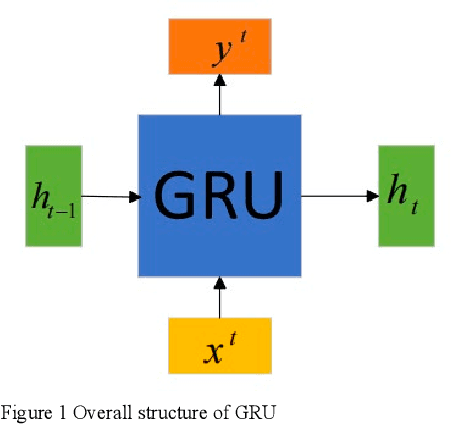


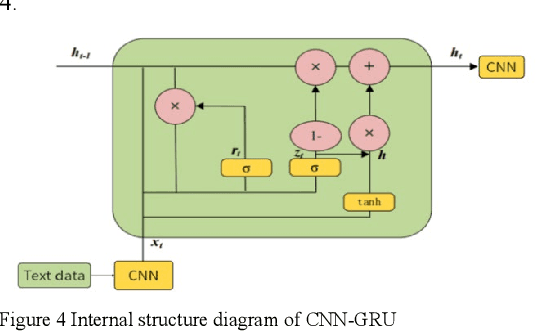
Abstract:This document presents an in-depth examination of stock market sentiment through the integration of Convolutional Neural Networks (CNN) and Gated Recurrent Units (GRU), enabling precise risk alerts. The robust feature extraction capability of CNN is utilized to preprocess and analyze extensive network text data, identifying local features and patterns. The extracted feature sequences are then input into the GRU model to understand the progression of emotional states over time and their potential impact on future market sentiment and risk. This approach addresses the order dependence and long-term dependencies inherent in time series data, resulting in a detailed analysis of stock market sentiment and effective early warnings of future risks.
 Add to Chrome
Add to Chrome Add to Firefox
Add to Firefox Add to Edge
Add to Edge